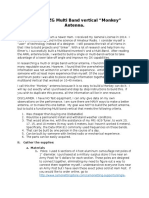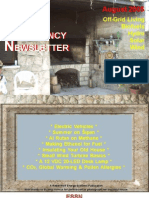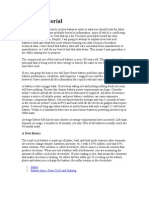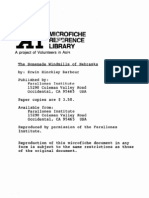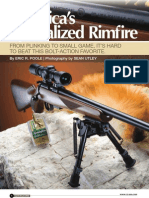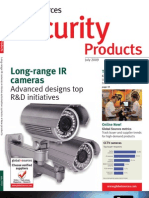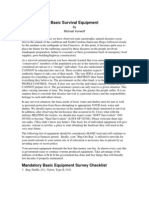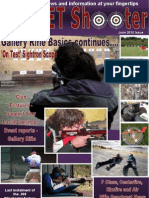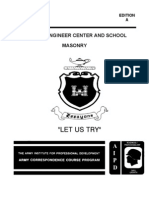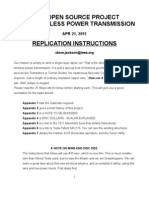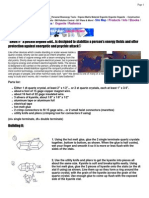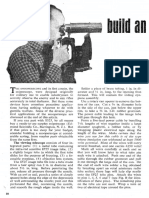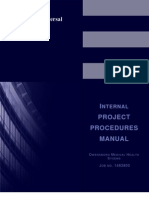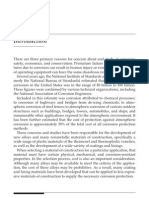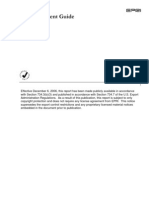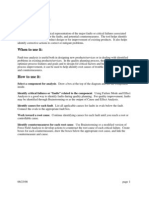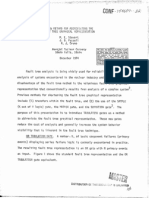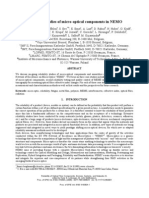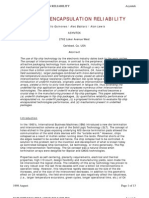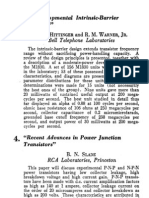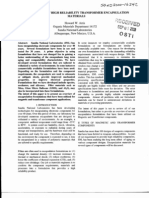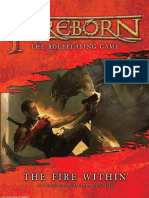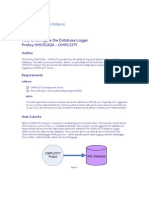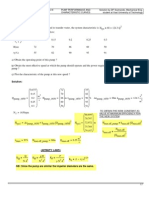Foxhole Radio
Foxhole Radio
Uploaded by
Susanoo12Copyright:
Available Formats
Foxhole Radio
Foxhole Radio
Uploaded by
Susanoo12Copyright
Available Formats
Share this document
Did you find this document useful?
Is this content inappropriate?
Copyright:
Available Formats
Foxhole Radio
Foxhole Radio
Uploaded by
Susanoo12Copyright:
Available Formats
8 BUILD A WORLD WAR II
FOXHOLE RADIO
It’s not quite an iPod, but in the field it will make
you feel very civilized!
Believe it or not, it’s easy to build a working radio that doesn’t use
electricity in less than an hour. Offering instant gratification, World
War II foxhole radios are simple, ingenious gizmos that reflect sound
moving through airwaves. Best of all is the pleasure of listening to
music under starry skies on an apparatus you built!
I did this project with my uncle, Dr. Richard Lanza, a nuclear engi-
neer at MIT’s Nuclear Engineering Department. Rolling out antennae
wire attached to a toilet paper roll in the halls of one of the most pres-
tigious institutions was beyond comical. Oddly enough, many of the
scientists who walked by smiled and made comments like, “I remem-
ber making one of those when I was a kid.” Who knows—making this
radio could be your first step toward MIT.
During World War II, GIs were often isolated from hearing the
day-to-day news of what was happening beyond their barracks. A few
clever radio-deprived GIs figured
out that they could use miscella-
neous scrap metal and junk to
construct a simple radio. Word
spread, and soon scores of soldiers
were creating their own radios.
Amazingly enough, these radios
did not require electricity or any
other power source. Here is a
chance for you to take a step back
in history.
024-39972_ch01_6P.indd 63 3/19/09 3:17:25 PM
Making a World War II Foxhole Radio
64
GEAR LIST
EXPLORER TOOL BOX
• Vintage-style fahnestock clips or paper clips
• 10 wood screws or thumb tacks
• 10 washers for the screws
• Needle-nose pliers
• Wire hanger
• Wooden board (a 1⁄2-inch-thick pine board is best)
• Coil form (you can use a cardboard toilet paper roll that’s at least
13⁄4 inches in diameter—2 inches is best)
• Number 2 lead pencil
• Single-edge safety razor (preferably “blued”; see step 13)
• Geranium diode—1N34A (from Radio Shack), optional
• 40 feet of #22 AWG coil or magnet wire
• 1 foot of #26 wire
• 100 feet of antenna wire or an antenna kit
• Sand paper
• Crystal earphone
• Safety pin
• Screw driver
• Spray lacquer
STEP 1: Cut the wooden board to which your radio will be attached.
The exact size is irrelevant, but it should be at least 6 × 6 inches to ac-
commodate all the parts.
STEP 2: Create coil form. This is the tube around which you are going
to wrap about 40 feet of copper wire. A toilet paper role will do, but it
might be a bit flimsy. If you can get your hands on thicker tubing, such
as the type used for gift wrapping paper, it will be more solid. In my
set I used a 4-inch wide tube.
STEP 3: Punch four tiny holes in the tube. The two holes at each end should
be about 1 ⁄2 inch from the end and about 1 ⁄4 inch apart. The two holes on
each end should run width-wise to the ends. (See illustration on page 65.)
STEP 4: Wind the wire tightly around the coil form. This may be ac-
complished in many ways, but ultimately wrapping it by hand is best.
It is very important that the coils be wrapped neatly next to each other.
024-39972_ch01_6P.indd 64 3/19/09 3:17:25 PM
65
Build a World War II Foxhole Radio
Allow for about 6 inches of excess wire on the right side of the tube. I
used magnet wire, which is a copper or aluminum wire covered with
thin insulation. If you go to a place like Radio Shack, ask for #22 AWG
(American Wire Gauge). It should be between 100 and 125 turns.
STEP 5: Tighten the coil manually by gripping it between both hands
and rotating your hands in opposite directions.
STEP 6: Spray the coil with
lacquer to help keep the
form wrapped tight. Allow
it to dry.
STEP 7: Attach the coil to
the board. Use either two
thumb tacks or two small
screws. The excess coil
wire should protrude from
the front side of the tube,
closer to the board, rather
than from the top of the
tube (see illustration).
STEP 8: Attach four wire
clips to the board—two on
each side of the board below the coil. They should be about 41 ⁄ 2 inches
apart from each other width-wise along the coil and about 11 ⁄ 2 inches
024-39972_ch01_6P.indd 65 3/19/09 3:17:25 PM
apart from each other on each side of the board (see illustration). The
top clips should be about an inch below the coil.
66
TIP: You can substitute paper clips for the clips and thumb tacks for
the screws. The idea is to be as innovative as the GIs in the field!
EXPLORER TOOL BOX
STEP 9: Make the tuner slider by cutting 7 or 8 inches of wire from a
wire coat hanger. If the hanger has any type of coating on it such as
paint, lightly sand it to improve contact points and reception.
STEP 10: Using needle-nose pliers, bend a loop around the bottom end
of the tuner slider. This loop will be wrapped around a screw and washer,
so bend it accordingly. You may want to attach a knob or ball of tape at
the top end of the slider as this is where your fingers will move the
slide later for tuning. About 3 inches below the coil, in the middle of
the board, attach the slider to the board by placing it on top of two
washers. Then screw it to the board firmly but not so tight that it in-
hibits the movement of the slider. The hook-up wires should go under
the washers for all contact points. (See illustration.)
STEP 11: Attach the safety pin, which will be the detector contact, to
a 2-inch piece of bare lead by bending the pin open about 90 degrees
(on the clasp side—see illustration) and wrapping the pin side with #26
wire. Sharpen the end of the lead with a razor.
STEP 12: Attach the safety pin to the board, using a washer and screw,
024-39972_ch01_6P.indd 66 3/19/09 3:17:26 PM
in the lower right-hand corner. Attach a wire between the safety pin
head and board with a washer and screw and wrap wire to the lower
67
right clip, which will ultimately be one of the headphone attachments
clips. The tip of the lead will ultimately come in contact with the side
Build a World War II Foxhole Radio
of the razor. (See illustration.)
STEP 13: Attach the razor blade, which will act as the radio’s crystal.
If you use a standard single-edged razor, it will need to be “blued” or
heat treated. To do this, attach it to some pliers in a vise and heat it
with a torch. (If you don’t have a torch, you can purchase one that’s
ready to go from a hobby shop.) Bend the safety pin so that the tip
touches the razor’s surface.
FYI During World War II, standard-issue razors were blued because
they remained sharper longer.
The crystal is the trickiest and most important part of this set. If
you want better reception, you might consider purchasing a Germa-
nium crystal detector from Radio Shack or from a radio hobby store
like Borden’s (Borden Radio Company, 138911 Kensington Place,
Houston, TX, 77034, www.xtalman.com).
I found that it was easier to work out the kinks in my set by using
the crystal detector before trying out the razor blade crystal.
STEP 14: Attach the rest of the wires according to the illustration. If
any of the connections or contact surfaces are lacquered or painted,
sand them lightly.
STEP 15: Attach a long wire to use as an antenna to the lower-left clip.
The longer and higher, the better—use between 50 and 100 feet of wire
of any type. Radio Shack sells some really great antenna kits for very
little money. I have found that it works fairly well to attach the antenna
high up on a tree.
TIP: If you want it really high, attach a weight and toss one end as high
up in the tree as possible.
Your radio must have a ground wire. Plumbing pipes work as do
flag poles. Experiment with different metal contacts. Attach the ground
wire to upper-left clip.
You are now ready to operate your foxhole radio! Don’t be frus-
trated if it does not immediately work. I found that I had to experi-
ment a lot with gently moving the tuning slider back and forth along
024-39972_ch01_6P.indd 67 3/19/09 3:17:26 PM
the coil. The antenna and grounding wires made a big difference in
how they were placed and how well they were connected.
68
I remember the first time I actually heard an AM station being
tuned in. It was a bit of a mind-blowing experience listening to a radio
EXPLORER TOOL BOX
on a device with no electrical parts.
I felt like I was listening to the propaganda DJs Tokyo Rose or Axis
Sally as the GIs did during World War II. It was the most fun I have
ever had with a radio. Enjoy listening to your new set.
024-39972_ch01_6P.indd 68 3/19/09 3:17:26 PM
You might also like
- Kamisama Kiss v07Document194 pagesKamisama Kiss v07JSA2343100% (1)
- How To Make An AtlatlDocument18 pagesHow To Make An Atlatlsoldatbr4183100% (1)
- Prepper Press Baofeng UV 5R Instruction ManualDocument13 pagesPrepper Press Baofeng UV 5R Instruction Manualdoomtroll8616No ratings yet
- 9-Crossfire 150R Parts ManualDocument40 pages9-Crossfire 150R Parts ManualoakstrNo ratings yet
- Coil GunDocument10 pagesCoil GunIkki MalikNo ratings yet
- Foxhole Radio LIMARCDocument30 pagesFoxhole Radio LIMARCdz99No ratings yet
- 10-40 Meter "Monkey" Multi Band VerticalDocument16 pages10-40 Meter "Monkey" Multi Band VerticalAnonymous 8FD9BLBNo ratings yet
- 2 Meter Backpack Quad AntennaDocument27 pages2 Meter Backpack Quad Antennaadel agustiNo ratings yet
- Handloads For The 327 Federal PDFDocument6 pagesHandloads For The 327 Federal PDFScott DNo ratings yet
- Engineers Pocket BookDocument51 pagesEngineers Pocket BookSivakumar ArulNo ratings yet
- Popular Mechanics - October 2014 USADocument110 pagesPopular Mechanics - October 2014 USAAnonymous PKVCsG100% (1)
- Raspberry PI Night Vision GogglesDocument6 pagesRaspberry PI Night Vision GogglesAdven TuresNo ratings yet
- Home Manufacture of Furs and Skins 1916Document298 pagesHome Manufacture of Furs and Skins 1916OllamhaAnneNo ratings yet
- Ms - 02 Introduction Important Symbols, Chain Terms, Chain Tools, Chain Identification, The Four Basic Rules & How To Maintain ChainDocument34 pagesMs - 02 Introduction Important Symbols, Chain Terms, Chain Tools, Chain Identification, The Four Basic Rules & How To Maintain Chaincrisdum78No ratings yet
- Types of Emergency KnotsDocument9 pagesTypes of Emergency KnotsGame AccountNo ratings yet
- Circuit Breaker Cross Reference GuideDocument2 pagesCircuit Breaker Cross Reference GuideGregClayNo ratings yet
- Cable Fault PrototypeDocument124 pagesCable Fault PrototypearnenylundNo ratings yet
- A Woodstove Compendium 1981 PDFDocument377 pagesA Woodstove Compendium 1981 PDFHeberNo ratings yet
- Build A Car: Karol Castañeda Deivy EspitiaDocument4 pagesBuild A Car: Karol Castañeda Deivy Espitiakarol castañeda0% (1)
- Low Cost HF Antennas & Accessories: Phil Salas - AD5XDocument42 pagesLow Cost HF Antennas & Accessories: Phil Salas - AD5XJack RodriguezNo ratings yet
- AirgunningDocument61 pagesAirgunningRajeev DudiNo ratings yet
- Basics On Diy Small Scale Windturbines and Domestic Power ConsumptionDocument36 pagesBasics On Diy Small Scale Windturbines and Domestic Power ConsumptionDennyHalim.com100% (5)
- Ender 3 InstructionsDocument16 pagesEnder 3 InstructionsKrkores4542No ratings yet
- Battery ImformationDocument173 pagesBattery Imformationadiguntemi100% (2)
- Class XII Foundry Practical ManualDocument42 pagesClass XII Foundry Practical ManualGosaye DesalegnNo ratings yet
- The Homemade Windmills of Nebraska (1899)Document79 pagesThe Homemade Windmills of Nebraska (1899)Stathis Kiousis100% (1)
- DIY Outdoor ShowerDocument10 pagesDIY Outdoor ShowerDejan RancicNo ratings yet
- How To Use A Dial Caliper: Activity Sheet 6Document5 pagesHow To Use A Dial Caliper: Activity Sheet 6Anoj pahathkumburaNo ratings yet
- Wire GaugeDocument10 pagesWire GaugeSwaraj DhumalNo ratings yet
- Armalite Technical Note 29 Rifle Cleaning InstructionsDocument4 pagesArmalite Technical Note 29 Rifle Cleaning InstructionsJohn M Buol Jr.No ratings yet
- How To Use A Vernier CaliperDocument11 pagesHow To Use A Vernier CaliperRoseCamilleGuzmanNo ratings yet
- America's Specialized Rimfire: From Plinking To Small Game, It'S Hard To Beat This Bolt-Action FavoriteDocument6 pagesAmerica's Specialized Rimfire: From Plinking To Small Game, It'S Hard To Beat This Bolt-Action FavoriteFestiCatNo ratings yet
- 2003 AllochrtDocument1 page2003 Allochrtam1liNo ratings yet
- Abner Doble PapersDocument13 pagesAbner Doble PapersAlvaro HiginoNo ratings yet
- Pop 1955 03Document132 pagesPop 1955 03Nano ZetaNo ratings yet
- ArcWeld B Alb ModDocument30 pagesArcWeld B Alb ModBlunder MajumderNo ratings yet
- 7 Foot Axial Flux Wind TurbineDocument25 pages7 Foot Axial Flux Wind TurbineJune BugNo ratings yet
- How To Make A Metal DetectorDocument12 pagesHow To Make A Metal Detectorhassan saadatpoorNo ratings yet
- Arb 702 IDocument2 pagesArb 702 Iyu3zaNo ratings yet
- Scout Regen v1.2.1Document47 pagesScout Regen v1.2.1vimaru88No ratings yet
- 2014-03 Micro Gasification Manual GIZ HERA RothDocument175 pages2014-03 Micro Gasification Manual GIZ HERA RothMario Santi100% (1)
- Security ProductsDocument81 pagesSecurity Productswilltsuru100% (2)
- Simple Antenna Theory For Ham - The Radio BuilderDocument3 pagesSimple Antenna Theory For Ham - The Radio BuilderbaymanNo ratings yet
- The Arrl Radio Amateur's Handbook - From Its BeginningDocument39 pagesThe Arrl Radio Amateur's Handbook - From Its BeginningMircea PetrescuNo ratings yet
- Cross BowDocument6 pagesCross BowTakeshi Goda100% (1)
- 7300 QH Stationary Gothic High-Tunnel Bender Instruction ManualDocument43 pages7300 QH Stationary Gothic High-Tunnel Bender Instruction ManualZlatko JusupovicNo ratings yet
- Arc Welding ProjectDocument11 pagesArc Welding ProjectLeahNo ratings yet
- Icom IC-R1:: The Ultimate Review, Modification & Restoration GuideDocument29 pagesIcom IC-R1:: The Ultimate Review, Modification & Restoration GuideLopez OrlandoNo ratings yet
- Survival Basic Survival EquipmentDocument5 pagesSurvival Basic Survival Equipmentjim100ab100% (1)
- How To Make A BBQ BurnerDocument14 pagesHow To Make A BBQ Burnerfoobar100% (1)
- Disorientation Devices: HistoryDocument1 pageDisorientation Devices: HistoryAl RepNo ratings yet
- Target Shooter JuneDocument102 pagesTarget Shooter JuneTarget Shooter100% (1)
- Us Army Engineer Center and School Masonry: Subcourse Edition EN5157 ADocument102 pagesUs Army Engineer Center and School Masonry: Subcourse Edition EN5157 ADan JohnsonNo ratings yet
- Wrought Ironwork - A Manual of Instruction for Rural CraftsmenFrom EverandWrought Ironwork - A Manual of Instruction for Rural CraftsmenRating: 5 out of 5 stars5/5 (1)
- The Book of the Springfield: A Textbook Covering all the Various Military and Sporting Rifles Chambered for the Caliber .30 Model 1906 Cartridge; Their Metallic and Telescopic Sights and the Ammunition Suited to ThemFrom EverandThe Book of the Springfield: A Textbook Covering all the Various Military and Sporting Rifles Chambered for the Caliber .30 Model 1906 Cartridge; Their Metallic and Telescopic Sights and the Ammunition Suited to ThemRating: 2 out of 5 stars2/5 (1)
- 6 Lab Making A Foxhole RadioDocument6 pages6 Lab Making A Foxhole RadioMaddy SjiicroNo ratings yet
- Jacksons Tesla Wireless Coil Instructions Apr 21 2011Document50 pagesJacksons Tesla Wireless Coil Instructions Apr 21 2011zunder12100% (1)
- How To Make The Shorty DeviceDocument3 pagesHow To Make The Shorty Deviceskalpsolo100% (2)
- Build An Infra-Red SnooperscopeDocument8 pagesBuild An Infra-Red SnooperscopeJOHNNo ratings yet
- Pipeline Fracture Experience - Cabral and Kimber 1997Document21 pagesPipeline Fracture Experience - Cabral and Kimber 1997Susanoo12100% (1)
- Constraint Programming: Michael Trick Carnegie MellonDocument41 pagesConstraint Programming: Michael Trick Carnegie MellonSusanoo12No ratings yet
- Session 11 12 - FMECADocument21 pagesSession 11 12 - FMECASusanoo12No ratings yet
- Tracey Ann - Dancehall Music Is Having Negative Impacts On Students 3Document6 pagesTracey Ann - Dancehall Music Is Having Negative Impacts On Students 3Susanoo120% (2)
- Constraint ProgrammingDocument31 pagesConstraint ProgrammingSusanoo12No ratings yet
- OMHS Procedures ManualDocument187 pagesOMHS Procedures ManualSusanoo12No ratings yet
- Pipeline DesignDocument94 pagesPipeline DesignSusanoo12100% (1)
- 1.1 Economic Losses: © 2010 by Taylor and Francis Group, LLCDocument4 pages1.1 Economic Losses: © 2010 by Taylor and Francis Group, LLCSusanoo12No ratings yet
- Fault Tree HandbookDocument218 pagesFault Tree HandbookRenzo Delgado100% (2)
- Drama GlossaryDocument9 pagesDrama GlossarySusanoo12No ratings yet
- Shaft Alignment ManualDocument76 pagesShaft Alignment Manualmjerkan100% (11)
- CO2 Well Drilling&Completion ProcedureDocument7 pagesCO2 Well Drilling&Completion Proceduresmithyry2014No ratings yet
- EUR22302ENDocument58 pagesEUR22302ENSusanoo12No ratings yet
- 15 FtaDocument2 pages15 FtaSusanoo12No ratings yet
- Lead-Acid Battery InfoDocument16 pagesLead-Acid Battery Infongt881No ratings yet
- A New Method For Abbreviating The Fault Tree Graphical RepresentationDocument4 pagesA New Method For Abbreviating The Fault Tree Graphical RepresentationSusanoo12No ratings yet
- Original PhotonicsEurope2006 - NEMODocument11 pagesOriginal PhotonicsEurope2006 - NEMOSusanoo12No ratings yet
- RD&D, Technology February 1999: A Proposed Strategy For Quality in Life-Cycle Asset ManagementDocument31 pagesRD&D, Technology February 1999: A Proposed Strategy For Quality in Life-Cycle Asset ManagementSusanoo12No ratings yet
- Solving Uv Curable ProblemsDocument4 pagesSolving Uv Curable ProblemsSusanoo12No ratings yet
- 1998 08 Asymtek Flip Chip Encapsulation ReliabilityDocument13 pages1998 08 Asymtek Flip Chip Encapsulation ReliabilitySusanoo12No ratings yet
- Reliable Internal Interconnects: For Magnetic SMT ComponentsDocument8 pagesReliable Internal Interconnects: For Magnetic SMT ComponentsSusanoo12No ratings yet
- Hittinger R. Warner,: " A Developmental Intrinsic-Barrier Transistor"Document2 pagesHittinger R. Warner,: " A Developmental Intrinsic-Barrier Transistor"Susanoo12No ratings yet
- An Overview of High Reliability Transformer Encapsulation Materials ,. - ? .,.Document7 pagesAn Overview of High Reliability Transformer Encapsulation Materials ,. - ? .,.Susanoo12No ratings yet
- 1 What Is "Asset Management"?Document7 pages1 What Is "Asset Management"?Susanoo12No ratings yet
- Gen - Ranjeet Dilshan - 20201016 - 000356Document1 pageGen - Ranjeet Dilshan - 20201016 - 000356Shaashwat SinghNo ratings yet
- The Islamic Pagan RootDocument14 pagesThe Islamic Pagan RootkishorebooksscribdNo ratings yet
- Chapter 3 PDFDocument27 pagesChapter 3 PDFAkshay WedhaneNo ratings yet
- 04 - Sanjana Bhandiwad - Assignment 2 - Basement ExcavationDocument27 pages04 - Sanjana Bhandiwad - Assignment 2 - Basement Excavation04BHANDIWAD SANJANA100% (1)
- Water Swivels and Hoisting PlugDocument4 pagesWater Swivels and Hoisting Plugsukhpreet singhNo ratings yet
- The Fire WithinDocument66 pagesThe Fire WithinLauraHenson100% (1)
- RS Handbook Fall Final 2022upDocument27 pagesRS Handbook Fall Final 2022upIbrahim AlifNo ratings yet
- 4281 - 03 Stiffened Shear WebDocument26 pages4281 - 03 Stiffened Shear WebAndrew GilbrideNo ratings yet
- Self Healing Technology For Asphalt PavementsDocument23 pagesSelf Healing Technology For Asphalt PavementsAhmedMahirNo ratings yet
- CIM HT006 Database Logger SetupDocument19 pagesCIM HT006 Database Logger SetupTony Choque RamosNo ratings yet
- Mathcad - 2Document4 pagesMathcad - 2Desejo SozinandoNo ratings yet
- Greek Life and Hooking UpDocument9 pagesGreek Life and Hooking UpKellen SangerNo ratings yet
- Prequalification List of Suppliers & Contractors FY 2022-2023 - 2023-2024Document14 pagesPrequalification List of Suppliers & Contractors FY 2022-2023 - 2023-2024gerald waihuiniNo ratings yet
- Join Telegram: Garimagoel007 - g2: Hand Written Short Notes Digestion and AbsoptionDocument18 pagesJoin Telegram: Garimagoel007 - g2: Hand Written Short Notes Digestion and AbsoptionChirag RajpalNo ratings yet
- Employee Wellness Plan 2024Document28 pagesEmployee Wellness Plan 2024BMHTech406_88926197No ratings yet
- Term 1 - MathsDocument10 pagesTerm 1 - MathsGaming TriadNo ratings yet
- CHAPTER3 Water Flow MeasurementsDocument8 pagesCHAPTER3 Water Flow MeasurementsMel CapalunganNo ratings yet
- stm8s105c4 956362Document122 pagesstm8s105c4 956362Welat YakubNo ratings yet
- Bump SteerDocument5 pagesBump SteerHimanshu Rajput100% (2)
- Thesis Activity UpdatedDocument1 pageThesis Activity UpdatedDainty Loren BarramedaNo ratings yet
- Detailed Courses: Rank Booster Questions Practice JEE Main and Advanced LevelDocument4 pagesDetailed Courses: Rank Booster Questions Practice JEE Main and Advanced LevelAkansha RawatNo ratings yet
- Polished PaperDocument116 pagesPolished Paperjoicylbarinque088No ratings yet
- Intro To Machine Learning With TensorFlow Nanodegree Program SyllabusDocument15 pagesIntro To Machine Learning With TensorFlow Nanodegree Program SyllabusTiberiu-Marius AvramNo ratings yet
- Climate Change and It Impact On EconomyDocument12 pagesClimate Change and It Impact On EconomyMeriem WannassyNo ratings yet
- Introduction To Programming: Pass Task 2.3: Hospital ChargesDocument3 pagesIntroduction To Programming: Pass Task 2.3: Hospital ChargesSyed MohiuddinNo ratings yet
- Paref Springdale School: Info - Office@parefspringdale - Edu.phDocument7 pagesParef Springdale School: Info - Office@parefspringdale - Edu.phFerminNo ratings yet
- Optimal Design of A Damped Dynamic Vibration AbsorberDocument21 pagesOptimal Design of A Damped Dynamic Vibration AbsorberShrikant DholeNo ratings yet
- Coating Specification DQC No: 004 Rev: I: ConfidentialDocument3 pagesCoating Specification DQC No: 004 Rev: I: ConfidentialAnny CordeiroNo ratings yet
- Week 1 - Introduction To Labour EconomicsDocument32 pagesWeek 1 - Introduction To Labour EconomicsChamiNo ratings yet






